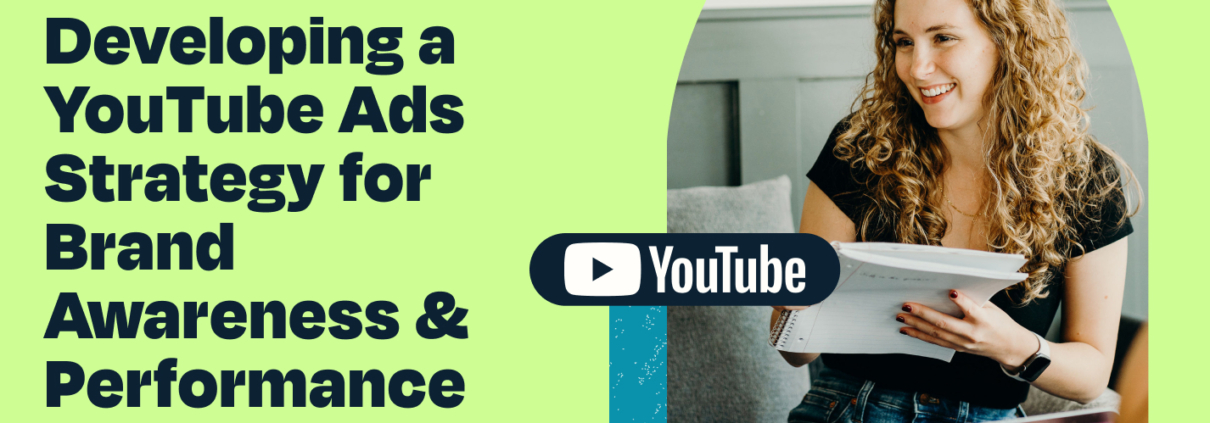Developing A Youtube Ads Strategy for Brand Awareness & Performance
With every passing year, brands are changing and adapting to the new growth climate. Automation is changing the game for most PPC channels, especially Google Ads. Data-driven creative is increasingly influencing all ends of the marketing mix. Video ads have been a staple for many years at this point, but continue to dominate our screens more and more each day.
YouTube has gone from an advertising channel that is a “nice to have” a few years ago and has morphed into a channel that is a must. With this opportunity though, comes lots of questions about strategy. What’s the right approach for this behemoth of an ad channel? What stage of the funnel does this play a role in? How is success measured?
We all use YouTube, at least 2.6 Billion of us that is, but here’s how Tuff thinks about YouTube fitting perfectly into every growth marketing strategy we develop.
YouTube Ads as a 2-Pronged Marketing Strategy
Typically, we utilize YouTube Ad campaigns by having one of two core goals – awareness or performance. Awareness campaigns are optimized to drive as many views and impressions as possible to a targeted audience in order to generate interest in the brand, while performance campaigns are optimized to drive action on the site with users taking a specific conversion action.
Both of these have their place in an overall Marketing Mix, but depending on the stage of your business, one may be more favorable than the other. Let’s dive in!
YouTube Advertising for Performance Marketing
Performance is the key word here. When utilizing YouTube Ads for performance marketing, the goal is to drive conversions. These may be leads, sales, or any other specific conversion event configured on your website that you’re looking to drive.
Choosing a Campaign Type
When launching YouTube campaigns for performance, we recommend using the Video Action campaign type. This campaign type is optimized to drive conversions on site. We would consider this to be the most similar to many Google Search bidding strategies that you may be familiar with: Target CPA, Max Conversions, Target ROAS.
While this campaign type will typically have higher CPVs than a Brand Awareness campaign, it will provide more conversions and should be measured by CPA and conversion volume. Optimizations should be based on the top performing creative and audience segments which are driving the lowest CPA possible.
Audience testing
So much of a Growth Marketing Strategy hinges on proper Audience testing. During a campaign launch, these should be continuously tested with the core KPI, CPA, being used as the north star when making optimization decisions. A very simple way to go about this is: audiences with the lowest CPA receive larger budgets over time and audiences with the highest CPAs should be removed from campaign targeting.
For performance based campaigns, we recommend choosing audiences that are higher intent and more likely to convert. For example, an Affinity audience for “Avid Investors” may be higher intent for offering financial services than a “Business Interest” audience may be.
Audiences can include Custom Segments, Affinity, In-Market, Interests, or retargeting lists. Retargeting will usually prove to be the highest intent group since they are familiar with your brand, but this is why testing is so useful. You may be surprised at how powerful some of YouTube’s audiences are.
Video Marketing
While selecting the correct campaign type is necessary and audience testing is a must, you have to also leverage creative testing to ensure that you are testing various messages that align with each stage of the user journey. The impact of data driven creative cannot be overstated here. It can make or break a campaign of any type, but this is especially true for video ads.
Conversion optimized campaigns targeting prospecting audiences are introducing the brand to new users. There is still plenty of room to test which message resonates best with this new audience, but the main focus is on introducing your brand or product. We like to test variations that include user generated content, bold animations, or strong explainer videos. These users are unfamiliar with you, so focus on engagement as well as conversion metrics once they are on the site. High engaging ads should get a larger percentage of your budget.
For retargeting, we can leverage more specific features or even put forth promotional messages that will appeal to users who are already familiar with the brand or product, but are still in the decision making stage.
Creatives should be optimized for specific devices as well. With the introduction of YouTube Shorts, there is another focus besides a standard 9×16 YouTube video ratio. Desktop and Mobile placements will behave differently, so this is important to keep top of mind when optimizing video ads.
We put together a list of YouTube Ad Examples you can check out here.
Evaluating Success
There are a few key metrics and KPIs that will be the main focus for a YouTube performance campaign. These are:
- Conversion volume
- CPA
- Conversion Rate
Performance based campaigns are just that, based on performance. This makes measuring success pretty straightforward and tied directly to leads, sales, or revenue. Since these conversion metrics are relevant for any ad channel, these YouTube Ads can be put up side by side to other channels for direct comparison.
One benefit of running a performance YouTube Ad campaign is that you can lean on CRO to help improve results. Small changes in conversion rate on your landing page can pay huge dividends in a short period of time. We always recommend integrating CRO wherever possible when testing and evaluating KPIs.
Utilizing YouTube As for Brand Awareness
YouTube truly excels at getting a brand in front of new faces. Remember, 2.6 BILLION active users. Basically endless opportunities to grow your audience. Here is how we tackle a brand play with YouTube Advertising.
Campaign type
In addition to optimizing YouTube campaigns for direct conversions, you want to leverage YouTube strategically to generate brand awareness. This is done by creating prospecting campaigns optimized for reach. The goal is to drive low CPMs and low CPVs. Traffic, traffic, traffic.
The two main bidding strategies for a Brand Awareness campaign on YouTube, are Manual CPV or Target CPM. One focusing on Views and the other on Impressions. Even though the main target is different, they are both focused on driving as many eyeballs to your ads as possible. We tend to start with a Target CPM and test throughout the campaign, but both are incredibly effective at driving views, impressions, and traffic to your site.
While these campaigns typically do not result in direct click-thru conversions, these campaigns can play a vital role in introducing the brand to as many people as possible.
What kind of Audiences are available?
In the Google Ads platform we have access to a plethora of prospecting audiences to work with. As mentioned above, these include the likes of Custom Segments, Affinity, In-Market, Interest, and Retargeting lists. The difference between Brand and Performance audiences is that with a Brand campaign, the goal is to go broad. You will want to focus on audiences that drive low CPMs and CPVs.
As we have continued to hammer home, testing audiences is a major key. Focus on audiences driving the cheapest traffic. Remove the ones that are expensive outliers. Besides the standard volume metrics, we recommend monitoring Time on Site metrics as well once users land on your site. Quality always matters, so remember to optimize towards the users who are the highest engagers.
For a full list of available audiences, check out this list from Vid Hoarder.
How is success measured?
Measuring success for a Brand campaign is not as straightforward as Performance campaigns. Brand KPIs are harder to both measure and communicate results. These campaigns are more of a long term play. Data does not necessarily roll in over night, but instead has lasting effects that can potentially affect all marketing channels months down the line.
When looking at daily and weekly data we monitor some pretty standard volume metrics. Optimizing copy, creative, and audiences lean on the data that comes in using these KPIs. If one creative has a much cheaper CPM then maybe shifting budget to favor that video ad is the right play. Sometimes certain audiences are more likely to click a YouTube Ad. In that case, we may tend to add more focus to those users over others. Here are the metrics in question:
- Impressions
- Clicks
- CPC
- CTR
- CPM
- CPV
- View Rate
Now when we are aiming to measure the long term, true impact of a YouTube Brand campaign, we dive a little deeper. Let’s use a financial planning client as an example.
Search campaigns are driving leads at a $20 CPL. Really efficient and abundant. Now, a YouTube Brand campaign may be only bringing in leads at a $200 CPL. At first look, it would be easy to decide that this campaign is just not working for you. When measuring with ROAS or CPL, the numbers do not lie.
The problem here is that these campaigns are not meant to be compared to one another. These numbers do not account for the thousands, or potentially millions of eyeballs that are exposed to your brand through a YouTube Brand campaign. Average Cost per View can easily be as low as $0.05. A single $1 can go a long way to reach new users.
This kind of exposure trickles down to Organic, Direct, and all other sources of traffic when measured over an extended period of time. Measuring lift in these other channels is imperative to evaluating success of a brand campaign.
During the campaign flight, is there a lift in Branded Search? Are more users coming in through Direct while this campaign is running? Has the percentage of New Users entering your site higher than before the YouTube campaign launched? All of these are questions that can be answered when evaluating your success. One of the best ways to do this is through isolated testing. Queue the next section please!
Isolated testing
For the cleanest possible measurement, these campaigns can be launched in isolation, meaning there are no additional top of funnel/brand awareness marketing efforts being added shortly before, during, or after the campaign run. Testing in isolation like this will help tremendously when communicating the data that rolls in.
One of the easiest ways to test in isolation is through specific Geographic targeting. This can be any GEO relevant to your business, but our recommendation is to focus on what we call 2nd tier geos. These are usually cities or states that rank in the top 10 of total users for your business, but are not the absolute highest traffic sources.
For example, New York might drive the most users on a monthly basis for your website. Instead of testing in your most important market, move down the list to another city, let’s say Chicago. Chicago has more than enough volume to bring in significant results, but is not the highest value market available. Once you find success in a market like Chicago, that gives you the go ahead to test in larger markets such as New York in this example.
The key here is to focus on a DMA that has significant volume. A smaller city such as Knoxville, won’t be able to provide abundant data nearly as quick as a city such as Chicago.
Campaigns are isolated, and have been running for 3 months. Now what? This is when you can utilize tools such as Google Analytics to accurately measure the impact of your flights. Focus on three areas of performance:
- KPIs before a campaign launch
- KPIs during the campaign
- KPIs after the campaign is over
Using data from all three of these timetables will help paint the picture of the effect of your brand YouTube campaign.
Back to our example of Chicago, if you saw 10,000 new users a month coming through Organic traffic before a campaign flight, and then saw an increase to 15,000 average monthly users coming in from Organic, this is a great sign that your brand efforts have had a positive impact. If now measurable lift is evident, this indicates potential creative or audience issues. Creative may not be resonating with the audiences you are targeting.
YouTube Advertising is not going anywhere anytime soon. No matter the business objective, hop on the train to get instant access to over 2 billion users. We have found Brand Awareness and Performance campaigns work well across all kinds of industries. It’s all a matter of testing and patience. Find the right mix between the two and great things are bound to happen.

Chris is a PPC Strategist based in Nashville, Tennessee. When he’s not scaling Google Ads & YouTube campaigns, he enjoys longboarding, tinkering with automation tools, and a little bit of gaming.






